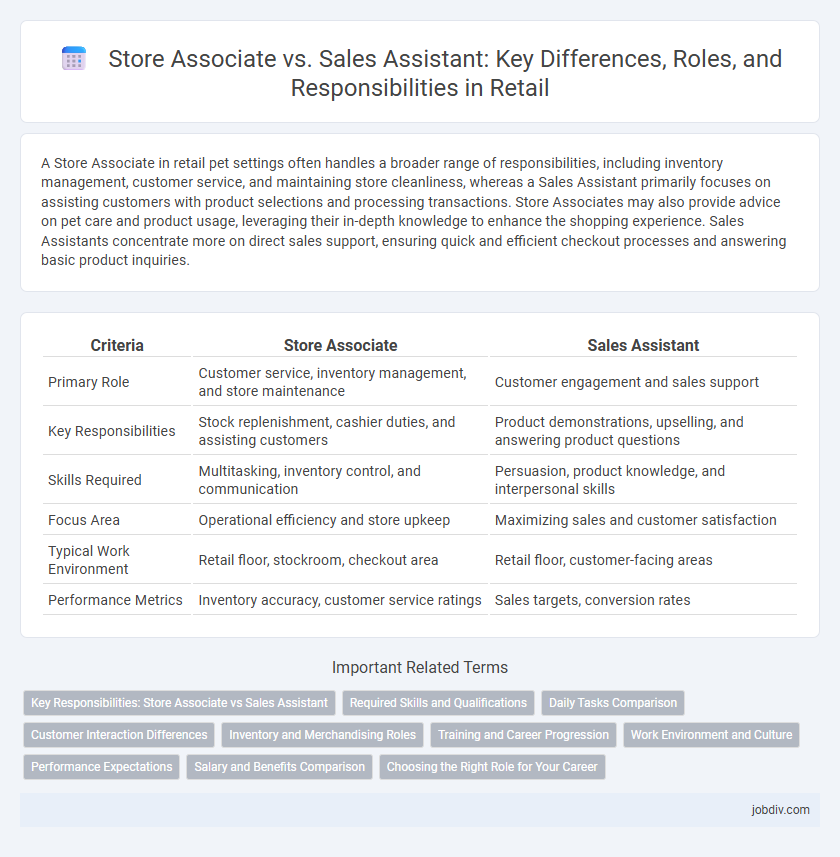A Store Associate in retail pet settings often handles a broader range of responsibilities, including inventory management, customer service, and maintaining store cleanliness, whereas a Sales Assistant primarily focuses on assisting customers with product selections and processing transactions. Store Associates may also provide advice on pet care and product usage, leveraging their in-depth knowledge to enhance the shopping experience. Sales Assistants concentrate more on direct sales support, ensuring quick and efficient checkout processes and answering basic product inquiries.
Table of Comparison
| Criteria | Store Associate | Sales Assistant |
|---|---|---|
| Primary Role | Customer service, inventory management, and store maintenance | Customer engagement and sales support |
| Key Responsibilities | Stock replenishment, cashier duties, and assisting customers | Product demonstrations, upselling, and answering product questions |
| Skills Required | Multitasking, inventory control, and communication | Persuasion, product knowledge, and interpersonal skills |
| Focus Area | Operational efficiency and store upkeep | Maximizing sales and customer satisfaction |
| Typical Work Environment | Retail floor, stockroom, checkout area | Retail floor, customer-facing areas |
| Performance Metrics | Inventory accuracy, customer service ratings | Sales targets, conversion rates |
Key Responsibilities: Store Associate vs Sales Assistant
Store Associates manage inventory, assist customers with product inquiries, and maintain store organization to enhance overall shopping experience. Sales Assistants focus primarily on engaging customers, processing transactions, and promoting sales through personalized product recommendations. Both roles contribute to revenue growth and customer satisfaction but differ in operational versus sales-oriented tasks.
Required Skills and Qualifications
Store Associates typically require strong customer service skills, product knowledge, and proficiency in inventory management systems, with a high school diploma as a minimum qualification. Sales Assistants prioritize excellent communication, persuasion abilities, and a friendly demeanor to engage customers effectively, often needing basic retail experience and sometimes a secondary education certificate. Both roles demand attention to detail, teamwork, and adaptability to fast-paced retail environments.
Daily Tasks Comparison
Store associates manage inventory restocking, assist customers with product information, and handle point-of-sale transactions, ensuring smooth store operations. Sales assistants primarily focus on engaging customers, recommending products, and maintaining visual merchandising standards to enhance shopping experience. Both roles contribute to achieving sales targets but differ in operational versus customer-focused daily responsibilities.
Customer Interaction Differences
Store Associates engage in comprehensive customer interactions by providing personalized product recommendations, handling inquiries, and managing returns to enhance the overall shopping experience. Sales Assistants primarily focus on assisting customers during transactions, restocking shelves, and maintaining store appearance with limited personalized interaction. The key difference lies in the depth of customer engagement, where Store Associates deliver tailored service while Sales Assistants support operational tasks.
Inventory and Merchandising Roles
Store Associates play a critical role in inventory management by monitoring stock levels, receiving shipments, and organizing backroom storage, ensuring the sales floor remains fully stocked. Sales Assistants primarily focus on merchandising tasks such as arranging products, setting up displays, and maintaining visual appeal to enhance the customer shopping experience. Both positions collaborate closely to optimize product availability and presentation, directly impacting store performance and customer satisfaction.
Training and Career Progression
Store Associates receive comprehensive training covering product knowledge, customer service, and inventory management, enabling them to handle diverse store operations. Sales Assistants typically undergo targeted sales training focused on customer interaction and merchandising skills. Career progression for Store Associates often leads to supervisory roles, while Sales Assistants usually advance towards specialized sales or customer service positions.
Work Environment and Culture
Store Associates typically work in dynamic retail environments with a focus on customer engagement and operational support, often requiring multitasking within fast-paced settings. Sales Assistants primarily focus on enhancing the customer shopping experience through direct interaction, product knowledge, and sales techniques, often in smaller or specialized retail spaces. Both roles emphasize teamwork and effective communication but differ in scope, with Store Associates handling broader store responsibilities while Sales Assistants concentrate more on sales-driven tasks.
Performance Expectations
Store Associates are expected to manage inventory, assist customers with product information, and ensure store cleanliness to maintain an efficient shopping environment. Sales Assistants focus primarily on driving sales, greeting customers, and providing personalized recommendations to enhance customer satisfaction and increase revenue. Both roles require strong communication skills and product knowledge, but Store Associates often carry additional operational responsibilities compared to the customer-facing sales focus of Sales Assistants.
Salary and Benefits Comparison
Store Associates typically earn an average hourly wage ranging from $12 to $17, while Sales Assistants often receive between $10 and $15 per hour, reflecting slight differences based on responsibilities and retail segments. Benefits for Store Associates frequently include health insurance, employee discounts, and paid time off, whereas Sales Assistants may receive fewer or more limited perks depending on the employer. Salary growth potential tends to be higher for Store Associates due to broader duties and opportunities for advancement within retail management.
Choosing the Right Role for Your Career
Store associates typically manage inventory, handle customer inquiries, and ensure store organization, making them ideal for those seeking a dynamic role with operational responsibilities. Sales assistants primarily focus on direct customer interaction and sales support, suited for individuals passionate about providing personalized service and driving sales targets. Assessing your skills in customer engagement and back-end operations will help determine whether a store associate or sales assistant role aligns better with your career goals.
Store Associate vs Sales Assistant Infographic

 jobdiv.com
jobdiv.com